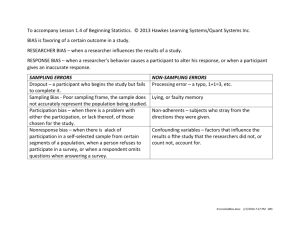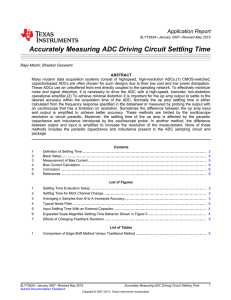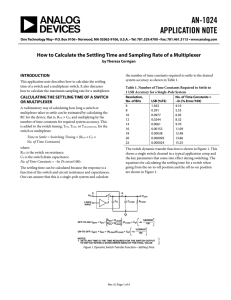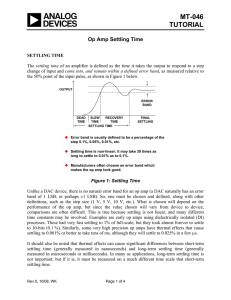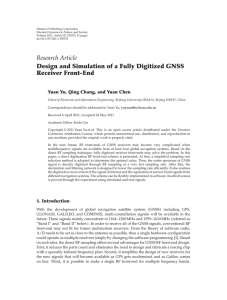Frequency Response Standard Technical Issues Howard F. Illian, President
advertisement
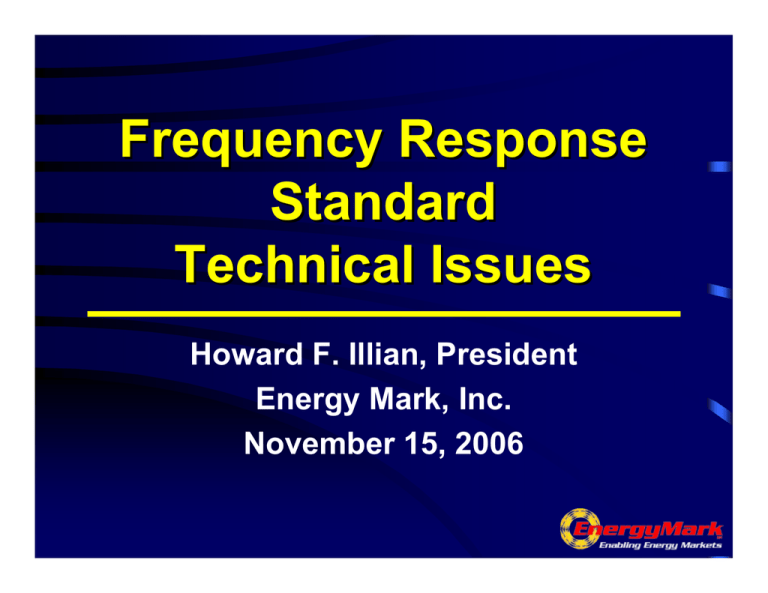
Frequency Response Standard Technical Issues Howard F. Illian, President Energy Mark, Inc. November 15, 2006 Overview ¾ ¾ ¾ ¾ ¾ Frequency Response Measurement Central vs. Local Measurement Sampling Procedures & Bias Local Measurement Limitation PGFR Measurement Change From Tie Line Error and Frequency To ACE, Bias and Frequency ¾ Significance of Measured PGFR Frequency Response Plot Frequency Response ¾ Initial Frequency – Point A ¾ Settling Frequency – Point B ¾ Minimum Frequency – Point C ¾ Oscillations – from C to B Measurement of PGFR ¾ Values of Interest Minimum Frequency Settling Frequency ¾ Minimum - High Resolution Data ¾ Settling Frequency – Step Function ¾ Use Two Step Measurement ? High Resolution Minimum Frequency Step Function Settling Frequency Consistent Minimum to Settling Ratio ? Central vs. Local Measure ¾ Central measurement can provide answers to reliability requirements. ¾ If reliability is affected significantly, then local measurement is required to assign responsibility for meeting minimum reliability needs. Sampling Procedures ¾ Frequency Threshold May tend to select lower response events ¾ Minute to Minute Unit Step Function Inconsistent selection method ¾ 3-Minute Unit Step Function Provides more consistent selection Provides multiple data values Enables internal consistency checking Frequency Threshold ¾ Assume 1,000 Mw Event: PGFR / 0.1 HZ Frequency Change A 1,000 MW 100 mHz B 2,000 MW 50 mHz C 3,000 MW 33 mHz ¾ 40 mHz Sampling Limit will select A and B from above but exclude C. Minute to Minute ¾ Assume 1,000 MW Event with a 2,000 MW / 0.1 Hz Response: Min Event at Avg 0 Sec 15 Sec 30 Sec 45 Sec 1 60.000 60.000 60.000 60.000 2 59.950 59.963 59.975 59.988 3 59.950 59.950 59.950 59.950 ¾ Use Minute 1 to Minute 3 average. Minute 1 - Minute 3 Sample ¾ Minute 1 to Minute 3 sampling provides 1 or 2 samples per event. ¾ Each event weighted equally. ¾ Multiple sample events enable the investigation of other data inconsistencies. ¾ This is still Frequency Threshold Sampling. Can we overcome the sampling bias in other ways? Measurement Limitation ¾ Balancing Authority Metering ∑ ET = 0 ¾ Therefore: ∑ ET,1 = 0 ⋅ & ⋅ ∑ ET,2 = 0 ¾ And: ⎞ = 0 ⋅ & ⋅ FR = 0 ⎛ ΔE T ∑ ⎜⎝ ΔF ⎟⎠ ∑ Local Measure Required ¾ These equations indicate that the information required determine the contribution to unreliability is contained in the local measurements. ¾ Therefore, local measurement is required to assign responsibility for provision of Frequency Response. ¾ The information is contained in combined Disturbance Imbalance Errors and the resulting Frequency Response to them. PGFR Measurement Change ¾ Change PGFR Measurement From Tie Line and Frequency To ACE, Bias and Frequency ¾ This change is dependent on the consistency of Variable Frequency Bias use. Significance of PGFR ¾ Frequency Error Drivers Normal Control Errors Disturbance Errors Disturbance Recovery Errors Scheduled Time Error Corrections ¾ Sensitivity Variables Epsilon 1 Generation and Transmission Inventory DCS Limits: Size and Recovery Limits Time Error Correction Procedures Questions




